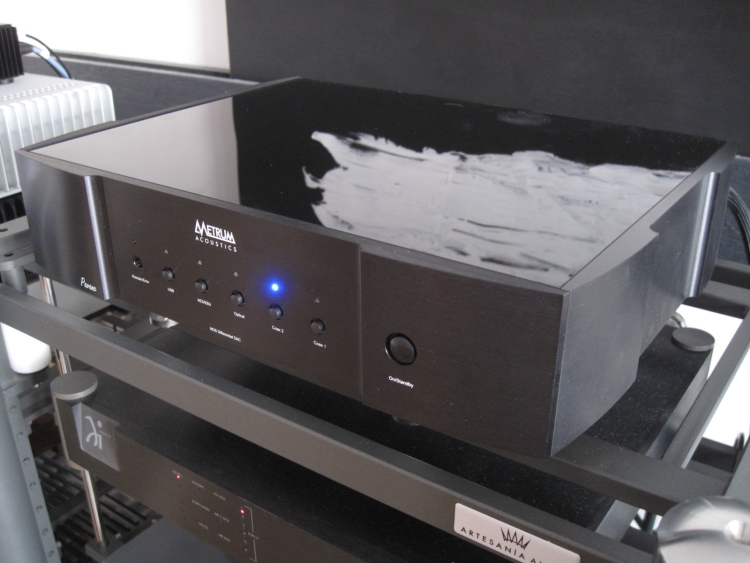
Non-Oversampling DAC with a clever design
Retail price in the Netherlands approx 5000 euro
The Pavane has been available for a while but for me, this is the first contact. It’s priced at a competitive price point (hardcore audiophiles would even call it affordable) and it has received universal praise. For me the interesting aspect would be to learn how it compares to the EC Designs Mosaic, which is also filterless with no oversampling.
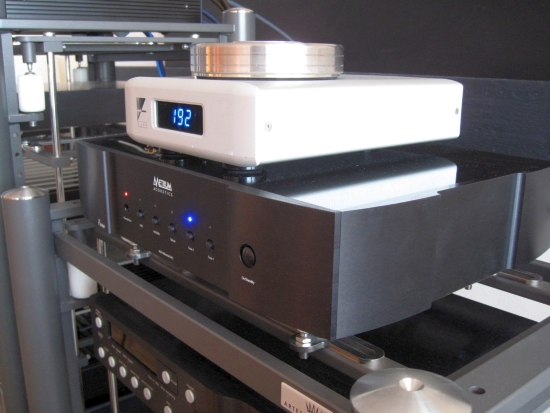
As this review is not meant to be as extensive as I normally do, I won’t go into huge detail on how the Pavane is built, but one main feature is that like the EC Designs Mosaic, the Pavane has no active output stage, whereby the DAC output is directly driving the analog output connectors. The interesting part is that Metrum utilizes 4 differential R2R Ladder DAC modules in parallel per channel.
Interlinks
The Pavane was listened to using its balanced XLR outputs using a Transparent Ultra XL and Cardas Hexlink Golden 5C interlinks as well as its cinch outputs using an AudioQuest Water interlink. Even if these 2 interlinks sound very different, the results seem to be consistent when comparing to other DACs using the same cables. The Water worked particularly well, retaining all of the Pavane’s subtlety and dynamics and adding some “meat on the bones”, improving its timbre.
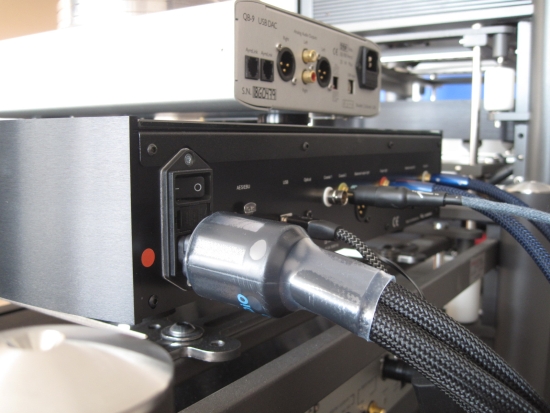
Above: the heavy Taiko power cable is held in place well by the Pavane’s sturdy connector
Power cables
Various power cables were used, and although the Pavane’s basic character is evident with all of them, they turn out to have a large influence on the resultant sound. The Pavane sounding most upbeat and powerful with a Furutech Alpha power cable, nicely smooth and relaxed with a Harmonic Technology Pro ACII power cable and somewhere in-between with the van den Hul Mainsstream. The absolute best match was with a Taiko Nagado (around 800 euro), which not only makes for a nicely luxurious sound while enlarging the soundstage in all dimensions and raising low-level detail, but also retains its speed and dynamics, and really lifts the Pavane to another level. Phase turns out to be crucial in extracting the maximum in PRAT and lyrical delivery from the Pavane. My unit had a mark on the “wrong” side of the IEC inlet. When connecting the power cable accordingly it sounded noticeably more upbeat then with the phase the other way around.
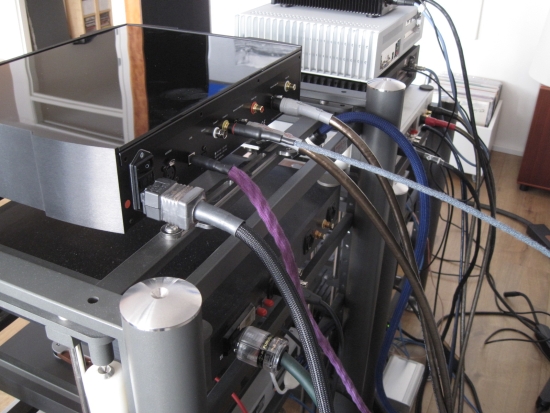
USB
The Pavane’s USB input is recognized by the Aurender N10 as a HiFace 2 interface and it must be said that this seemed to be audible, the DAC not really sounding coherent, or rather, its PRAT being sub-optimal when playing music using USB. Its technical qualities were all in order, but the emotion would not come. The Lyrical aspect of the music was subdued. Using its coaxial input instead made for a welcome increase in flow, helping the lyrical quality quite a bit.
A quick test with another USB cable, the Elijah Audio Quad Braid made for a much smoother sound but the cable could not help the Pavane in the emotion department.
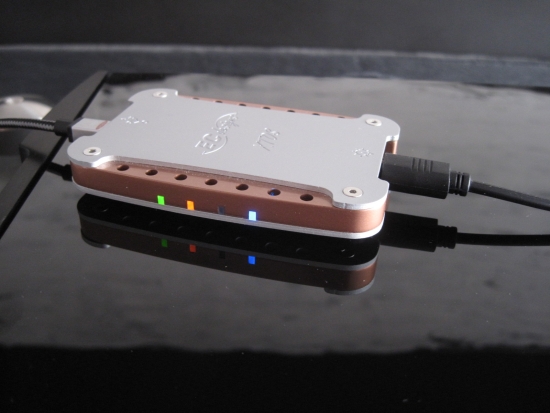
Using the N10 with a EC Designs XTOS USB to Toslink converter, however, made a large difference in terms of emotional delivery. Electrical S/PDIF however made for the best delivery and further listening was done using its coaxial input with the N10 as source with a Mad Scientist HDC Plus as digital interlink.
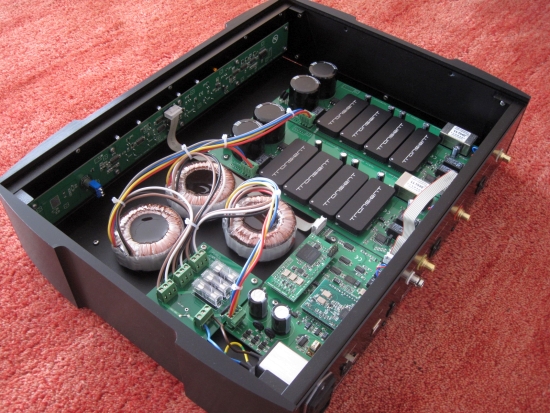
Sound
Like the Mosaic, the Pavane has a highly neutral and unforced sound. And like the Mosaic, it has a tendency to make normal DACs sound etched and hard in comparison. Also, like the Mosaic, the Pavane is very subtle and has a great differentiation of low-level detail. The DACs do differ in terms of delivery of power, the Pavane having a more solid bass and a wider soundstage. Performing on a similar level as the Mosaic I think is a great achievement in itself. Add to this its multiple inputs and outputs and it becomes clear that the Pavane is offering quite a lot for the money.
Nevertheless, it occurs to me that I am summing up the Pavane’s technical qualities rather than being captivated by its musical qualities. This is because I can’t help but feel that there is a “sober”, non-lyrical kind of quality about it. Especially when switching back to the Pavane after having listened to the characterful Wadia, Meridian and Leema for a period of time makes me realize that the Pavane is just a bit too strident for my taste.
The Pavane really does all the right things but doesn’t seem to really throw in the emotional registers. This is not just a matter of color/timbre, or dynamics, on the contrary: with the right cables, it has a very convincing timbre, and almost regardless of cable used it is plenty dynamic. It’s something else, like there is too much control, restricting the music to really flow effortlessly. While the Mosaic may not be as dynamic and punchy as the Pavane, it does present music with a natural flow and to me sounds emotionally more appealing.
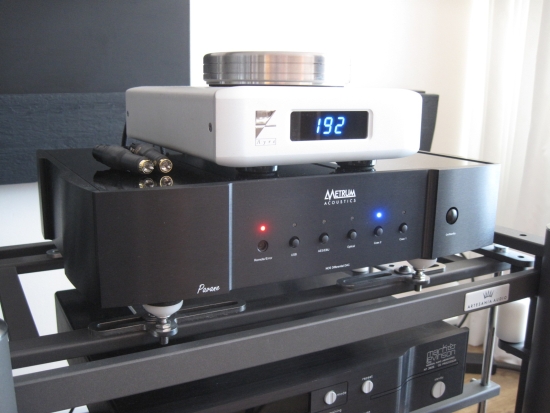
Ayre QB-9
In spite of different topologies, the Ayre QB-9 (original version) sounds similar to the Pavane on some levels: tonality/timbre, articulation, speed, focus, treble airiness, the subtle lack of body, all similar. The biggest difference being in terms of bass and overall power, the Pavane sounding larger and beefier. The Ayre, however, has a slightly more lyrical quality to it and is somewhat more supple and fluid. Thing is, I am comparing the Ayre with the same AudioQuest Diamond USB cable to the Pavane with the Mad Scientist digital cable. When comparing like to like, both using the same USB cable, the Pavane has to bow to the Ayre, for the latter then clearly has the upper hand in the emotional involvement department.
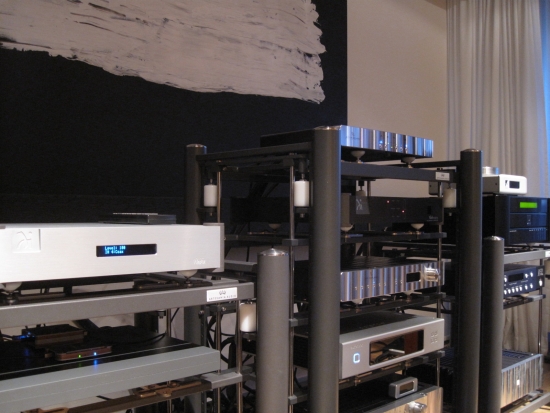
Wadia 521
Listening to the Wadia 521 after listening to the Pavane makes two things clear: first, the Pavane really is quite powerful and solid in the bass, but the Wadia is more solid and even more powerful, but that’s no surprise given my experience that Wadias are always more solid sounding than other DACs. Second, the Wadia’s treble at first instance seems more open than the Pavane’s (surprise) but turns out to be more etched than the Pavane’s. This is what listening to a NOS DAC can provoke. But listening to the Wadia for half a minute, my ears have already adjusted to its treble, while I am captivated from the first seconds by its soundstage depth and its lyrical and emotional, involving delivery.
Conclusion
I’m not really sure what to make of the Pavane. Is it something of a bargain? While it compares favorably to the excellent EC Designs Mosaic and the Ayre QB9, it only performs its best when not using its USB input. In its price range, it is definitely one of the top performers, and if it is the supremely etch-free NOS sound that you’re after, it may be one of the best options out there. If you crave rich tonal colors or lavish emotional involvement, however, I think there are better options around in its price range, although they will invariably sacrifice one or more of the Pavane’s strong qualities. As always, it is a matter of deciding which aspects of music reproduction matter most to you and finding the DAC to match them.

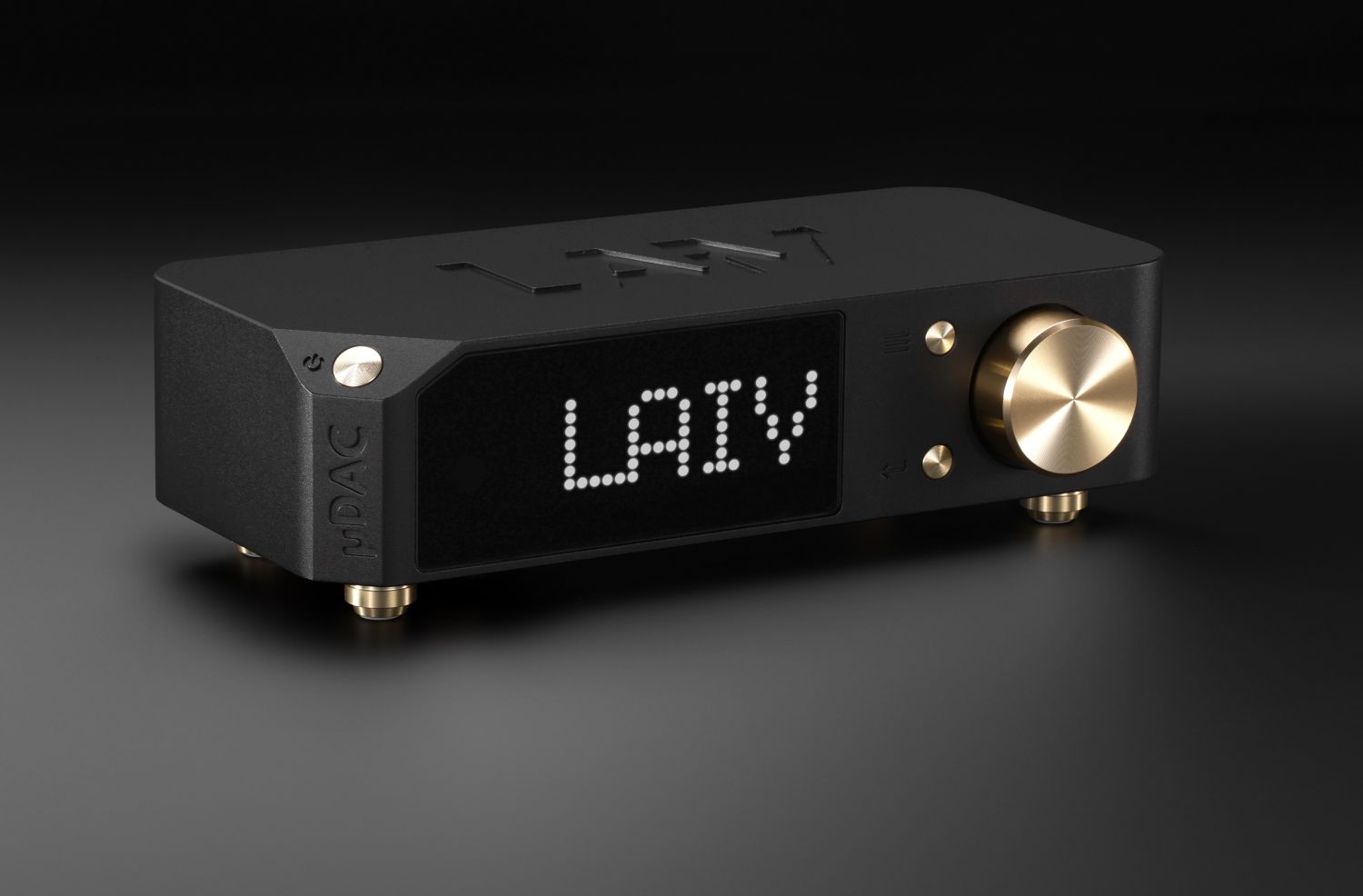






YES, Metrum Dac’s has a very high Resolution, thats why they are so open and detailed in all manner.., but is absolutely true, that emotionality and flow of the Music and at the end the colour of the Sound, has a lot to do with the Quality of the power cord!!
The Metrum Dac’s are very accurate.., thats why they are very sensitiv of power Quality!!
If you out there like me, uses a high filtering power cable.., the Metrum not only inreases the Resolution even more, it turns in a very natural colourfull Sound, very emotional with a incredible flow in the Music!
Just put 2-4 ferrits on your power cable cord that filters high frequency from 100Mhz down to 10 Mhz or even less & I promise you, this DAC is very very hard to beat!
You can hear this with classical Music or true cuban Music, where there are complex Instrumentation.., and you are able in any time, to here every Detail from each decay of Sound.., a lot more than any other Dac out there, no matter of Price!!
I am now sure after 3 Years listenig with Metrum, this has a lot to do with the Quality of the Dac modules itself and the layout of course in Hardware and Software!!
Maybe the Metrum Dac could Sound even better , like real live Sound, if the power supply would filtering more high frequency coming trough the power cable.., BUT PLEASE DONT FORGET TO BURN IN A METRUM DAC AT LEAST 100 HOURS!!
Enjoy the Music!!
Thanks for your message John. I tried various power cables with the Metrum, even a 2600 euro specimen, but somehow I did not manage to find the magical combination. Timbre/colour is a personal matter and in hindsight I can’t blame the Metrum for not sounding as tonally full as a Wadia or as rich as a Jeff Rowland. They’re just different animals. This particular Metrum was a used model so I assume that it must have played over 100 hours, but I can’t be sure. In any event its character did not match well in my setup. It wasn’t something on a technical level, as you mention correctly that it is certainly honest and very hi-res, rather I just could not connect with it on an emotional level. It could be argued that my system just needs a little extra enthusiasm or character from a DAC, and maybe the Metrum did not like the other components that were connected to the same power outlet, but I’ve heard several other, very hi-res DACs in the same setup and they don’t necessarily all sound measured. Just yesterday a friend brought along a dCS Elgar. This DAC is very highly resolving but does not sound technical at all, rather it is smooth and fluid and even sounds a little warm. I know that the Metrum is almost universally admired and so I was also surprised with this outcome. As much as I try to bring out the best in any component, system dependency and personal taste do remain a factor, and perhaps the Metrum is just too neutral or well-behaved for my system or taste.
Thanks for your reply Mr.Punter
Your reviews are great and very helpful, because you are neutral, & yes, because our impression in Music are quite the same by all of us.., only the preferences are different between us!!
So like Mr.Punter wrote.., the Metrum Dac are probably the best Option, if you wish a etch-free, clean Sound, from ‘botton to top’!!
But don’t let us forget a very important aspect to match a source well into the rest of the System:
Like I wrote above, Metrum has not only a very high Resolution Dac modules inside, but also a very high bandwidth Output!!
A compression effect can be avoid, if the rest of the System operates in high bandwidth too (Amp, Speakes)!!
If not, music flow & emotionality will always suffer!!
Its amazing to recognize, how MP3(320kbps) sounds more lively in some less bandwidth Systems, as CD Quality or even more!!
At the end, I dont think that this Dac needs an exotic power cable to win a bit more emotionality, rather a good high filtering power System, like with the ‘oehlbach power’, that inreases the Resolution even more too!!
Enjoy the Music!!
Hello Mr.Punter
You wrote:
{My unit had a mark on the “wrong” side of the IEC inlet. When connecting the power cable accordingly it sounded noticeably more upbeat then with the phase the other way around.}
WHAT DO YOU MEAN WITH WRONG SIDE??
THE PIN ON THE RIGHT SIDE OF THE INLET MUST BE THE PHASE!
FINALLY, WICH WAY DID YOU CONNECTING THE POWER CABLE.., CORRECT IN PHASE OR THE OTHER WAY??
‘MORE UPBEAT’ IS FOR YOU THE BETTER SOUNDING WAY??
Thanks for your Reply!!
Best Regards
Hi John, please see this article that explains where the phase “should” be. However, it is not a very hard rule and not all manufacturers follow this. I even encountered several mono amps of the same brand and type that had different connections.
More upbeat for me means faster, more lively, more spritely, more engaging. Also see the HFA audiophile lingo glossary.
Hi Mr. Punter
Thanks for your reply.., & nice review of the Valencia Show!!
Yes, thats correct, like I wrote before.., the male pin on the right side of the Pavane is the phase, or should be.., not that one on the left side!
SO FINALLY, TO GET THE MORE UPBEAT SOUND OUT OF THE PAVANE, WICH WAY DID YOU CONNECT THE POWER CABLE.., CORRECT IN PHASE LIKE IT SHOULD BE, OR THE OTHER WAY??
(no matter where the mark was of the IEC inlet)
Best regards
I don’t recall the mark but assume that I connected it as standard, as per the info I supplied. Unsatisfied with the sound I may even have experimented with the phase as I know that this can matter for the PRaT.
The issue with the Pavane is that the USB input is notoriously mediocre. The only input that should be used to maximize the potential of the Pavane is I2s. There’s a VERY large difference in sound between USB and I2s. AES is acceptable but still far from I2s from a realism, timbre and dynamics standpoint.
Aha! That makes a lot of sense and explains why some are raving about it while others (myself included) find something to be amiss. I did indeed encounter the same issue with other DACs later and that’s why I now prefer to use S/PDIF or AES/EBU. Thanks for the info!
Christiaan, i also own a pavane and, Just like you felt that the sound was not enough emotionally involving, not vivid or lively enough. You wrote that with the Taiko Ngado powercable it sounded far better, but not enough. I found that this Taiko cable is also using a female connector of the Oyaide brand, type to me is unknown. After reading your review (2017) of the Oyaide C004 connector, i thought what the heck. If it still is your reference today why not give it a try. After having used the standard powercord and an Eichmann Xpress, and an Mway 3d plus, without satisfaction, i terminated the Oyaide C004 on the Mway, instead of the standard Iego copper. This gives the pavane a much more vivid and Lively sound. Now i really can enjoy listening to it. I do not have an Aqua xhd dac for comparison, but would argue that the greyness is totally gone, after the change of the connector. Thank you very much for your thorough reviews, it really helped me.
Thanks for the feedback, Mark! Glad to hear my reviews help:-)